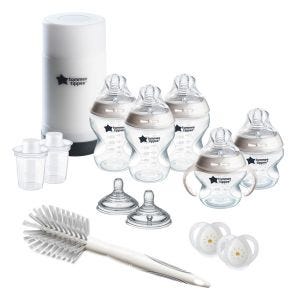
This is a demo store. No orders will be fulfilled.
Subscription orders can be cancelled at anytime. Free delivery on all subsequent subscription orders. Find out more about subscriptions.
They’re easy and fuss free
Your products are automatically sent to you
You save up to 10% when you sign up for a subscription
You can cancel at any time
The choice to give a baby a pacifier (also known as a dummy or soother) is a very personal one and it's often an emotionally charged topic that's discussed amongst mums and dads.
Some parents don't include a pacifier in their baby's routine at all and manage without one, but others (around two-thirds) do choose to use a pacifier to soothe their little one when they're unsettled or crying and find that a pacifier satisfies their baby's natural non-nutritive sucking reflex when they're not feeding.
Others find that they were initially against using a pacifier, but when their baby arrives, they change their mind, and that's totally ok!
When it comes down to it, the choice is entirely yours. Remember to trust your parental instincts and don't feel swayed or disheartened because of the judgement of others.
To help you decide, let's run through when pacifiers can be introduced, some of the advantages and disadvantages of pacifiers, and how you can introduce a pacifier safely.
Pacifiers can satisfy a baby's natural sucking instincts when they're not feeding, and many find sucking on a pacifier very soothing when they're distressed or trying to fall asleep. They can also provide relief during times of stress, for example, if you're attending a medical appointment.
Finally, although more research is needed in this area and the exact correlation is unclear, there've been studies suggesting that pacifier use alongside breastfeeding may reduce the risk of cot death - also known as sudden infant death syndrome or SIDS.
The truth is, pacifiers get dropped on the floor regularly and can carry bacteria if they're not kept thoroughly clean. This may lead to increased infections and tummy upsets, so be sure to regularly sterilize your little one's pacifiers, and always keep a few spares handy to replace any dirty pacifiers that end up on the floor.
If they're used for too long, pacifiers may affect how a baby's teeth grow, which is why it's best to always use orthodontic pacifiers and take your little one for their first visit to the dentist once their first tooth emerges.
Using a pacifier for a prolonged amount of time may stop your baby from babbling and therefore slow the process of them learning to talk, so it's best to stop using a pacifier between the ages of six and 12 months if you can.
If you decide that you'd like to give your baby a soother, it's best to wait until around four weeks after birth to give you both time to settle into your feeding routine (whether you're breastfeeding or bottle feeding) and to give your baby time to learn how to get milk from your nipple or the teat of a bottle.
If you introduce a pacifier before they're settled into a steady feeding routine, there's a chance that your little one could get confused between feeding and suckling, which may lead to feeding problems.
Yes, they can. To help establish a regular sleep routine, you can offer your baby a pacifier before you put them down to sleep (during the day or night) alongside following other safe sleep guidelines.
If their pacifier falls out of your baby's mouth while they're asleep and they don't wake up, there's no need to put it back in. If they do wake up, they'll soon let you know if they want it back again!
Our Breast-Like Nighttime Soothers glow in the dark so they're easier to find in the middle of the night!
It's important to note that not all babies will like a pacifier and you should never force your little one to accept their pacifier.
If your little one seems to be resisting their pacifier, try offering it when they're more relaxed or towards the end of a feed, but if they continue to refuse their pacifier, don't force them as this will only cause more distress for you both.